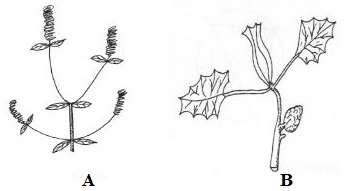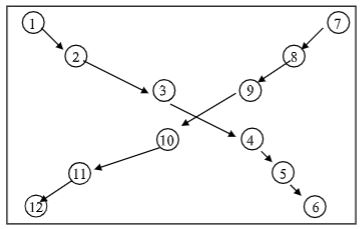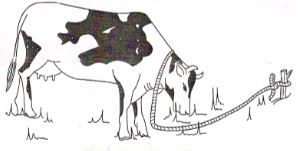AGRICULTURE
PAPER 1
Instructions to candidates:
- This paper contains three sections A, B and C
- Answer ALL the questions in section A and B
- Answer any Two questions from section C
Questions
SECTION A (30MKS)
Answer ALL the questions in this section in the spaces provided
- State two reasons why farmers should be encouraged to practice organic farming (1mk)
- State two ways in which crop rotation controls weeds (1mk)
- Name two methods of sowing pasture crops (1mk)
- State four qualities considered when selecting seeds for planting (2mks)
- State four advantages of crop rotation (2mks)
- State three physical agents of weathering in soil formation (1 ½ mks)
- Give three properties of a foliar fertilizer which makes it possible to be used as a foliar Feed (1 ½ mks)
- Give three reasons why Banana should be pruned (1 ½ mks)
- State four factors considered when classifying crop pests (2mks)
- Give four reasons for land fragmentation (2mks)
- State two mechanical methods used in separating soil in soil analysis (1mk)
- State three ways in which inorganic fertilizers are classified (1 ½ mks)
- State three effects of raindrops on bare soil ( 1 ½ mks)
- Give three reasons why layering would be preferred to the use of cutting as a method of raising planting materials ( 1 ½ mks)
- State the forms in which nitrogen is absorbed by plants (1mk)
- Outline four factors which effect herbraidal selectivity (2mks)
- State four natural factors that may influence soil erosion (2mks)
- Name four disadvantages of zero grazing (2mks)
- Outline four factors which encourage soil erosion (2mks)
SECTION B (20 MKS)
Answer ALL Questions in this section
- Below are illustrations of common weeds. Study them and answer the questions that follow
- Identify the weeds (2mks)
- State the harmful effects of the weed B above (1mk)
- Give four advantages of leasehold tenure systems (2mks)
- Describe the procedure which should be followed when spraying a crop of onions using a fungicide in powder form, water and a knapsack sprayer (5mks)
-
- What is soil sampling? (1 mark)
- Below is a method of soil sampling. Use it to answer the question that follow.
- What method of soil sampling is represented above? (1 mark )
- name the other method of soil sampling (1mark)
- Outline three areas which should be avoided during soil sampling. (3 marks )
-
- Identify the rotational grazing system shown below (1mk)
- Give the FOUR advantages of the system named above (4mks)
SECTION C (40MKS)
Answer any two Questions in this section
-
- Describe harvesting of pyrethrum under the following sub-headings
- Procedure (4mks)
- Precautions (6mks)
- Describe the safety measures observed when handling farm herbicides (10mks)
- Describe harvesting of pyrethrum under the following sub-headings
- Describe the production of Rhodes grass (Chloris gayana) under the following sub-headings
- Land preparation (5mks)
- Pasture establishment (8mks)
- Maintenance (7mks)
-
- Discuss the production of beans under the following sub headings
- Land preparation (4mks)
- Varieties (2mks)
- Selection and preparation of planting materials (5mks)
- Field management practices
- Explain the method and procedure of harvesting of sugarcane (4mks)
- Discuss the production of beans under the following sub headings
Marking Scheme
- Reasons for organic farming
- Helps to balance features of fertile soul e.g. organic matter and soil micro organisms
- Use of local materials
- Lessens skills in preparation e.g. green manure
- Affordable and cost effective ½ x2 = 1 mark
- Ways in which crop rotation controls weeds
- Cover crop smoothens weeds if alternated with other crops
- Crops associated with specific weed as are alternated with crops of different families to remove appropriate host and break life cycle of weeds
½ x 2 = (1mk)
-
- undersowing
- over sowing
- Direct sowing
-
- High germination percentage / be viable
- Be healthy / be free from diseases and pests
- Have high vigour
- Have no physical damage
- Be pure / no impurities / clean
- Be uniform in size / colour / shape
- Suitable to ecological conditions ½ x 4 = 2
- Control sol born pests of diseases
-
- Consume soil / prevent soil erosion
- Ensure maximum utilization of soil nutrients
- Help in weed control
- Improve soil structure
- Improve soil fertility
- Offer security incase of crop failure ½ x 4
-
- Running water
- Moving ice
- Wind
- Temperature
-
- Should not have any scotching effects on the plants
- Be easily absorbed by the leaves
- Used in spray form / soluble in water 1 ½ mks
-
- To control banana weevils
- To spread the production
- To produce large bunches ½ x 3 = ( 1 ½ mk)
-
- Where pests are found
- Feeding habit / type of damage
- Scientific / biological classification
- Crop attacked
- Stage of development of past at which it causes damage
- Stage of growth at which crop is attacked
- Part of crop attacked
-
- Buying or selling / paying debts / compensation
- Inheritance
- Settlement and resettlement
- Gift or donation
- Shifting cultivation ½ x 4 = 2 mk
-
- Mixing soil with water then shaking / stirring and allowing particles to settle / sedimentation
- By use of series of sieves with different meshed size ½ x 2 = 1mk
-
- According to the nutrients they contain
- According to soil reaction / effect o soil pH
- Time of application
½ x 3 = 1 ½ m
-
- Splash erosion/ cause soil erosion
- Expose seeds
- Causes hard pans / soil capping / destroy soil structure
½ x 3 = 1 ½ m.
-
- When cutting cannot root if detached from mother plant
- Where large planting materials are pre-faced / rooting system
- Faster production of planting materials / quick growth /
- Higher chances of survival
- Has well established rooting system
½ x 3 = 1 ½ mk
-
- Nitrate form / nitrate ions /
- Ammonium form / Ammonium ions / NH4+ ½ x 2 = 1mk
-
- Age of the weeds
- Plant morphology
- Plant physiology
- Metabolic factors
- Chemical concentration
- Stage of crop growth
- Rooting system
½ x 4 = (2mks)
-
- Amount of rainfall/ rainfall intensity
- Slope / topography
- Type of soil
- Size of intershade / catchment
- Length of slope
- Wind velocity / strength of wind
- Vegetative cover
½ x 4 = 2 mks
-
- high initial capital
- high management
- high labour
- diseases can easily spread
(½ x 4 = ( 2mks)
-
- Lack of ground cover
- Steep slopes
- Shallow soils
- High rainfall intensity
- Overstocking
- Pear method of cultivation
- Deforestation ½ x 4 = 2mrks
-
-
- A - Devil’s horse whip (Achyranthes apora) ( 1mk)
- B - Datura stramomium (Thorn apple) (1mk)
-
- Poisonous to livestock
- Competes with crops for nutrients / light / water or space
- Increase cost of production
- Lower yields / quality 1x1 = 1mk
-
- Enables land owners / landlord to earn income from land
- Enable people who have no land to have acres to farmers land
- Idle land put into productive use
- Enable tenants to increase / decrease acreage of land leased depending on profitability
½ x 4 = ( 2mks)
-
-
- Read the label / manufacture instructions and follow them
- Measure the required amount of fungicide
- Place the fungicide into a container and mix thoroughly with a little water / pre-mix (pre-cream) until it forms a uniform slurry
- Pour the mixture into the knapsack sprayer through the sieve
- Top up / add up to the required level on the knaprack sprayer
- Spray the mixture onto the cap as required 1 x5 = 5 marks
- Observe the procedure
-
- it is a process of taking small quantities of soil from the field to act as a representative sample of soil in that particular field
-
- traverse methode
1 x3 = 3 mks - zigzag method
-
- dead furrows
- Terrace stands
- Old fences lines
- Old manure heaps
- Swampy areas
- Near trees and boundaries
- Between slops and bottom lands
1 x2 = 2 mks
- traverse methode
- it is a process of taking small quantities of soil from the field to act as a representative sample of soil in that particular field
-
- tethering
-
- Maximum utilization of pasture
- Distribution of animal wastes uniformly
- Pastures are is given time to regrow before it is grazed again
- Reduce the build of pests and diseases
- Allow excess pasture to be harvested for conservation (1 ×3 =3mk)
- tethering
-
-
- Pick flowers selectively
- Pick flower with horizontal petals / three to two roses of disk florets
- Use fore finger and thumb
- Pick by twisting the lead so that no stem is left attached
- Put the pricked flowers in woven baskets 1x 4 = ( 4mks)
- Picking starts 3 -4 months after planting
-
- Picked flowers are put in woven baskets to allow ventilation and avoid fermentation
- Wet flowers should not be picked since they heat up and ferment
- Should not be comp[acted to avoid heating up and fermentation
- Suitable picking intervals 14 – 21 days to avoid overgrown or young flowers
- Break flower stalks to maintain quality 1 x6 = 6 mks
-
-
- Land preparation
- Clear the land to remove all stumps
- Dig, plough the land to remove perennial weeds / roots
- Harrow the land ; to a fine filth
- Prepare the land during the dry season / before the rains 1 x5 = 5 mks
- Pasture establishment
- Select a desirable variety of grass for the ecological condition / select the correct
- variety for the same zone
- Plant or the onset of rains / plant early
- Use certified seeds
- Drill / broad cast the seeds evenly
- Apply phosphatic fertilizers or appropriate rate
- Use ssp rate of 200- 300 kg/ ha
- Use recommended seed rate for the variety
- Use 1.5-2 kg /ha PGS / 5-10 /ha for any available seed
- Drag a twig / gunny bag to cover the seeds lightly
- Cover seeds 3-5 times the diameter of seeds / depth 1x8 = 8 mks)
- Maintenance
- Control weeds by uprooting /use herbicides
- Top dress with nitrogenous fertilizers
- Top dress with nitrogenous fertilizers
- Top dress in split application
- Cut / graze in the initial stage when 4- 6 months
- Control pests and diseases when they appear
- Avoid grazing when too young / Early defoliation
- Topping posture using appropriate method when to stemmy
- Carry out controlled grazing
- Irrigate when desirable
- Re – seeding when need be 1x7 = 7mk
- Land preparation
-
-
- Land preparation (4mks)
- Prepare land during dry season/before onset of rains
- Clear land using pangas/slasher/mower/an axe
- Carryout primary cultivation
- Dig deep to eradicate perennial weeds
- Carry out secondary cultivation to obtain a medium tilth
(Any 4)
- BEAN VARIETIES (2MKS)
- Dry bean varieties:
- Rose coco (GPLZ)
- Mwezimoja (GPLZ 1004)
- Canadian wonder (GPLZ24)
- K74
- Wairimu
- Mexican 142
(any 2)
- French bean varieties
- Monel
- Saxa
- Masterpiece
- Longtom
- Dry bean varieties:
- SELECTION AND PREPARETION OF PLANTING MATERIALS (5MKS)
- Select fully dried beans
- Avoid wrinkled or damaged seeds
- Select certified seeds/high purity seeds/seeds with high germination percentage
- Dress seeds with appropriate chemicals to control soil borne pests
- Inoculate seeds with the right strain of rhizobium
- To facilitate Nitrogen Fixation leading to high yields
- select seeds suitable to prevailing ecological conditions
(ANY5MKS)
- FIELD MANAGEMENT PRACTICES (5MKS)
- Weeding should done before flowering to avoid knocking down flowers
- Weed using hand tools and earth up the plants
- Irrigate the plants if rainfall is unreliable
- Use overhead irrigation before flowering
- Control pests such as aphids using appropriate chemicals
- Control American bollworm and bean fly using appropriate pesticides
- Control bean anthracnose and bacterial halo blight diseases using appropriate chemical
- Top dressing should be done after weeding using CAN or foliar feeds
- Land preparation (4mks)
- METHODS AND PROCEDURE OF HARVESTING SUGARCANE (4MKS)
- Harvest when mature for plant crop 18-20months and at the coast 14months
- Ratoon crop 16months and at the coast 12 months
- Harvest at the right stage when sugar content is highest/harvest after taking cane to the factory for quality testing
- Cane is cut at ground level to ensure high yield and props establishment of the ratoon crop
- strip the leaves using a cane matchet
- Cut off green tops to avoid growth auxins flowing backwards this lowers the quality of sugar
- Use sterilized equipment/cane harvesting matchet
- Deliver the to the factory within 24hours
-
Download Agriculture Paper 1 Questions and Answers - Form 4 Opener Term 1 Exams 2022.
Tap Here to Download for 50/-
Get on WhatsApp for 50/-
Why download?
- ✔ To read offline at any time.
- ✔ To Print at your convenience
- ✔ Share Easily with Friends / Students




